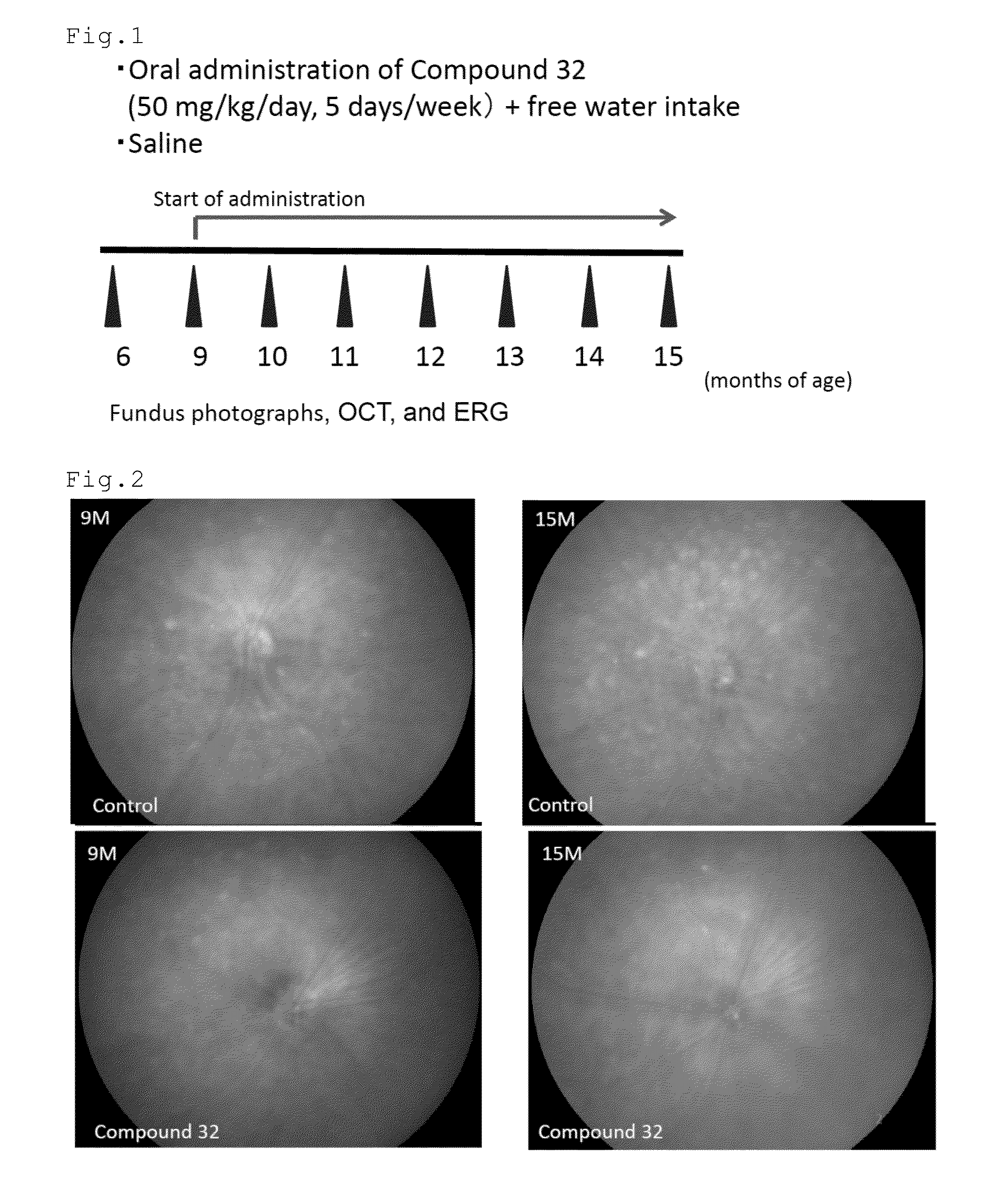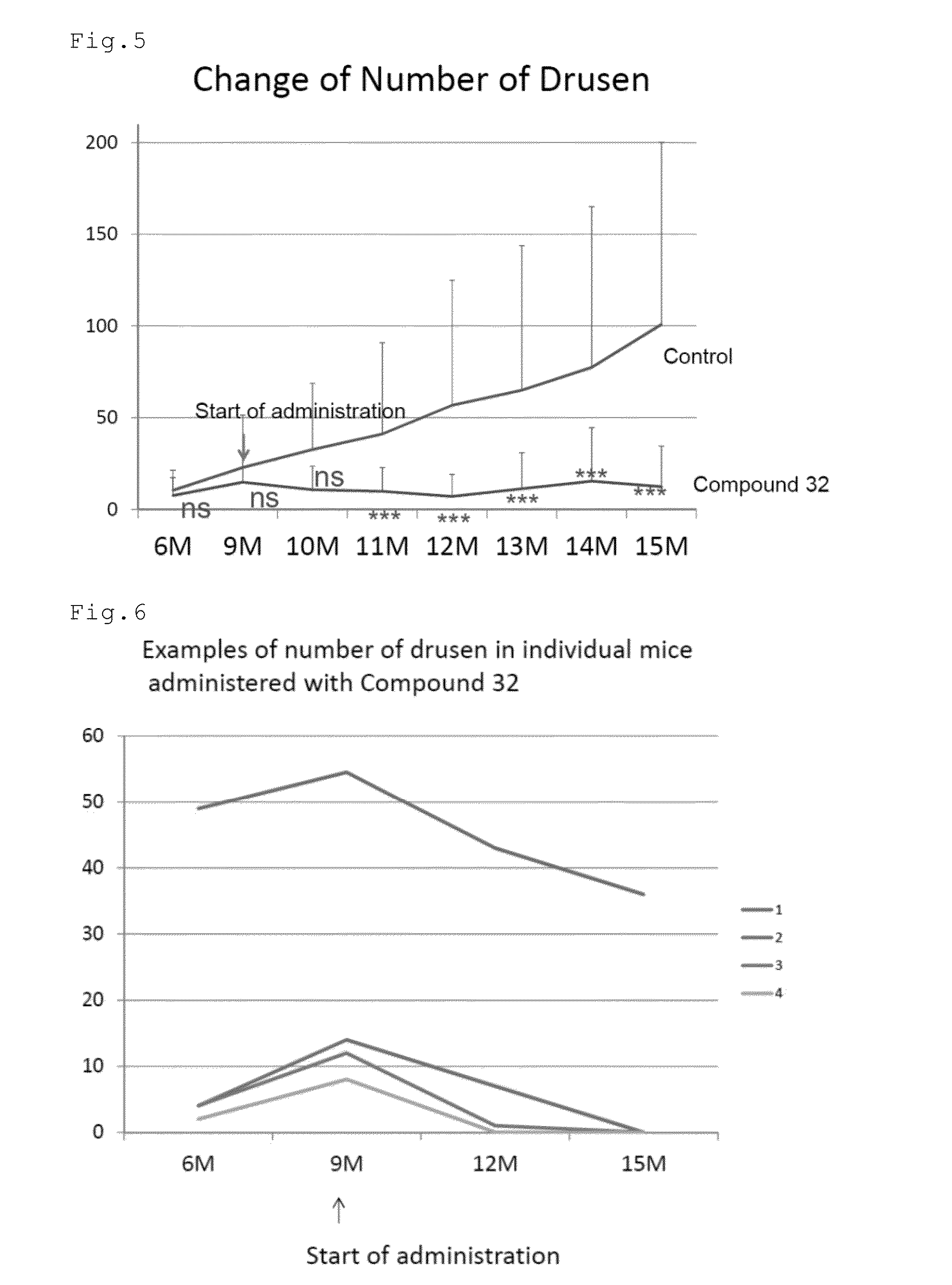Method For Treating Eye Diseases
a technology for eye diseases and treatment methods, applied in the direction of biocide, anti-noxious agents, drug compositions, etc., can solve the problems of poor prognosis, no such therapy is currently available, blindness in the elderly, etc., and achieve the effect of preventing age-related macular degeneration and suppressing the formation of drusen
- Summary
- Abstract
- Description
- Claims
- Application Information
AI Technical Summary
Benefits of technology
Problems solved by technology
Method used
Image
Examples
example 1
Compound 32: Synthesis of 4-amino-3-[6-(4-fluoro-2-methylphenyl)pyridine-3-ylazo]naphthalene-1-sulfonic acid sodium salt
[0090]
(i) 2-(4-Fluoro-2-methylphenyl)-5-nitropyridine
[0091]2-Chloro-5-nitropyridine (5.0 g, 31.5 mmol) and tetrakis(triphenylphosphine)palladium (0.35 g, 0.3 mmol) were added to 1,2-dimethoxyethan (50 ml), then degassed and purged with nitrogen three times under reduced pressure. Under nitrogen atmosphere the mixture was stirred at room temperature for 20 minutes, 4-fluoro-2-methylphenylboronic acid (31.5 mmol) and 2M aqueous sodium carbonate (31.5 ml) were poured in, and the temperature was raised to 80° C. After the reaction an 80° C. for 3 hours, the mixture was cooled to room temperature and extracted with addition of ethyl acetate and water. The organic layer was dried with anhydrous sodium sulfate, and concentrated under reduced pressure. The products were purified by column chromatography to give the title compound.
(ii) 6-(4-Fluoro-2-methylphenyl)pyridine-3-...
example 2
Experiment 1: Removal of Drusen in Aged Mice
[0096]The effect of the compound of number 32 (Compound 32) to remove previously formed drusen in relatively aged mice was tested. CCR2 (monocyte chemoattractant protein 1 (MCP-1) receptor) deficient mice were used. The mice in the group of Compound 32 (n=30 eyes) were orally administered with 50 mg / kg / day of Compound 32 dissolved in saline five days week from the age of nine months. The mice in the control group (n=48 eyes) were orally administered with the saline. The mice in the both groups were allowed to freely drink water. At the age of 6, 9, 10, 11, 12, 13, 14, and 15 months, the mice were examined by fundus photographs, optical coherence tomography (OCT) (Multiline OCT, Heidelberg Engineering) and electroretinogram (ERG). FIG. 1 shows the scheme of Experiment 1.
[0097]FIGS. 2 to 4 show the fundus photographs at the age of 9 and 15 months. The white dot-like structures are the drusen. In the control mouse, the drusen increased in the...
example 3
Experiment 2: Suppression of Formation of Drusen in Young Mice
[0099]The effect of the compound of number 32 (Compound 32) to suppress the formation of the drusen in young mice was tested. CCR2 deficient mice were used. The mice were allowed to freely drink water containing 0.385 mg / ml of Compound 32 from the age of two months. The mice in the control group were allowed to freely drink water not containing Compound 32. At the age of 2, 3.5, 6, and 9 months, the mice were examined by fundus photographs, OCT, and ERG. FIG. 8 shows the scheme of Experiment 2.
[0100]FIGS. 9 to 11 show the fundus photographs at the age of 3.5, 6, and 9 months. The white dot-like structures are the drusen. In the control mouse, remarkable increase of the drusen is observed in the area bounded by the line in FIG. 10. In the mouse administered with Compound 32, the drusen did not increase. Remarkable suppression of the formation of the drusen is observed particularly in the area bounded by the line in FIG. 11...
PUM
| Property | Measurement | Unit |
|---|---|---|
| temperature | aaaaa | aaaaa |
| pH | aaaaa | aaaaa |
| temperature | aaaaa | aaaaa |
Abstract
Description
Claims
Application Information
 Login to View More
Login to View More - R&D
- Intellectual Property
- Life Sciences
- Materials
- Tech Scout
- Unparalleled Data Quality
- Higher Quality Content
- 60% Fewer Hallucinations
Browse by: Latest US Patents, China's latest patents, Technical Efficacy Thesaurus, Application Domain, Technology Topic, Popular Technical Reports.
© 2025 PatSnap. All rights reserved.Legal|Privacy policy|Modern Slavery Act Transparency Statement|Sitemap|About US| Contact US: help@patsnap.com



